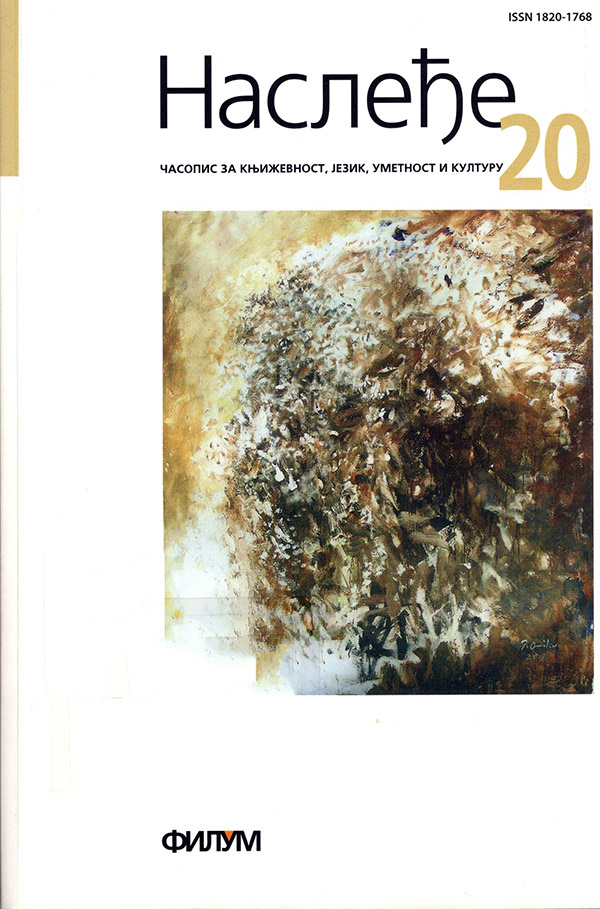ЈЕВРЕЈСКИ ИДЕНТИТЕТ У РАНОЈ МОДЕРНОЈ ЕВРОПСКОЈ ИСТОРИЈИ
Кључне речи:
Јевреји, ренесанса, идентитет, антијудаизам, визуелна диференцијација, слика другог, интеграција, менталне и визуелне презентацијеСажетак
Јеврејски идентитет у раном модерном периоду – епохи у којој традиционално антијеврејство прераста у антисемитизам – обликован је насиљем, изгоном, гетоизацијом, формама визуелне диференцијације, интеграцијом, али не и асимилацијом у оквире европске хришћанске културе. Изучавањем односа интелектуалних и физичких категорија, душе и тела као социјалних и историјских конструкта, може се, донекле, одговорити на питање шта то значи бити Јеврејин у раном модерном добу. На основу искустава актуелних протогониста и посматрача, у њиховој сопственој реалности, овај текст представља перцепцију и самоперцепцију Јевреја у менталним и визуелним кодовима ренесансе.
Референце
Bear 2001: Y. Bear, A History of the Jews in Christian Spain, Vol. II, From the Fourteenth Century to the Expulsion, The Jewish Publication Society of America, Philadelphia.
Bere 1998: P. Bere, The Jew as Renaissance Man, Renaissance Quarterly 51/1, 128–162.
Berger 1997: D. Berger, Anti-Semitism: An Overview, in: D. Berger ed., History and Hate: The Dimensions of Anti-Semitism, Philadelphia.
Bonfil 1988: R. Bonfil, How Golden was the Age of the Renaissance in Jewish Historiography?, History and Theory (Essays in Jewish Historiography) 27/4, 78–102.
Bonfil 1994: R. Bonfil, Jewish Life in Renaissance Italy, Berkeley.
Bonfil 1994: R. Bonfil, Changing Mentalities in Italian Jews between the Periods of the Renaissance and the Baroque, Italia 11, 61–79.
Bonfil 2001: R. Bonfil, A Cultural Profile, in: R. C. Davis, B. Ravi eds., The Jews of Early Modern Venice, The John Hopkins Univ. Press, 169–190.
Брајовић 2009: С. Брајовић, Ренесансно сопство и портрет, Београд.
Burke 1991: P. Burke, The Language of Gesture in Early Modern Italy, in: J. Bremmer, H. Roodenburg eds., A Cultural History of Gesture, Ithaca and New York: Cornell Univ. Press, 71–83.
Burke 2001: P. Burke, Eyewitnessing: The Uses of Images as Historical Evidence, Ithaca, Cornell Univ. Press.
Chazen 2004: R. Chazen, The Jews of Medieval Western Christendom 1000–1500, Cambridge 2004.
Cohen 1982: J. Cohen, The Friars and the Jews: The Evolution of Medieval Antisemitism, Ithaca, Cornell Univ. Press.
Eilberg-Schwartz 1992: H. Eilberg-Schwartz, The Problem of the Body for the People of the Book, in: H. Eilberg-Schwartz ed., People of the Body: Jews and Judaism from an Embodied Perspective, Albany, State Univ. of New York, 17–46.
Friedman 1987: J. Friedman, Jewish Conversion, the Spanish Pure Blood Laws and Reformation: A Revisionist View of Racial and Religious Antisemitism, The Sixteenth Century Journal 18/1, 3–30.
George 2002: E. V. George, Conceal or Disclose? The Limits of Self-Representation in the Letters of Juan Luis Vives, in: T. Van Hondt, J. Papy eds., Self-Presentation and Social Identification. The Rhetoric and Pragmatics of Letter Writing in Early Modern Times, Leuven Univ. Press, 405–426.
Gutwirth 2009: E. Gutwirth, Jewish Bodies and Renaissance Melancholy: Culture and the City in Italy and the Ottoman Empire, in: M. Diemling, G. Veltri eds., The Jewish Body. Corporeality, Society, and Identity in the Renaissance and Early Modern Period, Leiden, Boston, 57–92.
Harrán 2008: D. Harrán, Between Exclusion and Inclusion: Jews as Portrayed in Italian Music from the Late Fifteenth to the Early Seventeenth Century, in: D. Myers, P. Reill eds., Acculturation and Its Discontents: The Jews of Italy from Early Modern to Modern Times, Univ. of Toronto Press, 72–98.
Idel 2009: M. Idel, On the Performing Body in Theosophical-Theurgical Kabbalah: Some Preliminary Remarks, in: M. Diemling, G. Veltri eds., The Jewish Body. Corporeality, Society, and Identity in the Renaissance and Early Modern Period, Leiden, Boston, 251–272.
Jestice 2007: P. G. Jestice, A Great Jewish Conspiracy? Worsening Jewish-Christian Relations and the Destruction of the Holy Sepulcher, in: M. Frassetto ed., Attitudes Toward the Jews in the Middle Ages, New York, 25–42. Kennedy 1994: W. J. Kennedy, Authorizing Petrarch, Ithaca, Cornell Univ. Press.
Klibansky, Panofsky, Saxl 1964: R. Klibansky, E. Panofsky, F. Saxl, Saturn and Melancholy: Studies in the History of Natural Philosophy, Religion, and Art, London.
Lelli, 2004: F. Lelli, Biography and Autobiography in Yohanan Alemanno’s Literary Perception, in: D. B. Ruderman, G. Veltri eds, Cultural Intermediaries: Jewish Intellectuals in Early Modern Italy, Univ. of Pennsylvania Press, 25–38.
Lesley 1992a: A. M. Lesley, The Place of the Dialoghi d’Amore in Contemporaneous Jewish Thought, in: D. B. Ruderman ed., Essential Papers on Jewish Culture in Renaissance and Baroque Italy, New York Univ. Press, 170–188.
Lesley 1992b: A. M. Lesley, Jewish Adaptation of Humanist Concepts in Fifteenth and Sixteenth-Century Italy, in: Essential Papers on Jewish Culture in Renaissance and Baroque Italy, New York Univ. Press, 45–62.
Lesley 2009: A. M. Lesley, Giving Birth to the Hebrew Author: Two Compositions by Johanan Alemanno, in: M. Diemling, G. Veltri eds., The Jewish Body. Corporeality, Society, and Identity in the Renaissance and Early Modern Period, Leiden, Boston, 273–300.
Miletto 2009: G. Miletto, The Human Body as a Musical Instrument in the Sermons of Judah Moscato, in: M. Diemling, G. Veltri eds., The Jewish Body. Corporeality, Society, and Identity in the Renaissance and Early Modern Period, Leiden, Boston, 377–394.
Mirandola 1994: Đ. Piko dela Mirandola, Govor o dostojanstvu čovekovu, prevod, uvod i napomene S. Gudžević, Beograd.
Nirenberg 2002: D. Nirenberg, Mass Conversion and Genealogical Mentalities: Jews and Christians in 15th Spain, Past & Present 174, 3–41.
Nochlin 1995: L. Nochlin, Starting with the Self: Jewish Identity and Its Representation, in: L. Nochlin, T. Garb eds., The Jew in the Text: Modernity and the Construction of Identity, London, 7–19.
Oberman 1984: H. Oberman, The Roots of Anti-Semitism in the Ages of the Renaissance and Reformation, Philadelphia.
Owen Huges 1986: D. Owen Huges, Distinguishing Signs: Ear-Rings, Jews and Franciscan Rhetoric in the Italian Renaissance”, Past & Present 112, 3–59. Porter 1991: R. Porter, History of the Body, in: P. Burke ed., New Perspectives on Historical Writing, Cambridge, 206–232.
Pullan 1997: B. Pullan, The Jews of Europe and the Inquisition of Venice, 1550–1670, London.
Rietes 1981: J. W. Rietes S.J., St. Ignatius Loyola and the Jews, Studies in the Spirituality of Jesuits 13/4, 17–45.
Rowan 1985: S. Rowan, Luther, Bucer, and Eck on the Jews, The Sixteenth Century Journal 16/1, 79–90.
Shear 2004: A. Shear, Judah Moscato’s Scholarly Self-Image and the Question of Jewish Humanism, in: D. B. Ruderman, G. Veltri eds, Cultural Intermediaries: Jewish Intellectuals in Early Modern Italy, Univ. of Pennsylvania Press, 149–177.
Shulvass 1985: M. A. Shulvass, The History of the Jewish People, Chicago. Simon 1991: M. Simon, Christian Anti-Semitism, in: J. Cohen ed., Essential Papers on Judaism and Christianity in Conflict: From Late Antiquity to the Reformation, New York Univ. Press, 131–173.
Simonsohn 1996: S. Simonsohn, Giovanni Pico della Mirandola on Jews and Judaism, in: J. Cohen ed., From Witness to Witchcraft: Jews and Judaism in Medieval Christian Thought, Wiesbaden, 403–417.
Simonsohn 1991: S. Simonsohn, The Apostolic See and the Jews, Toronto. Soufas 1990: T. Scott Soufas, Melancholy and the Secular Mind in Spanish Golden Age Literature, Columbia-London 1990.
Ultsch 2000: L. J. Ultsch, Sara Copio Sullam: A Jewish Woman of Letters in 17th-Century Venice, Italian Culture 18, 73–86.
eltri 2004: G. Veltri, Philo and Sophia: Leone Ebreo’s Concept of Jewish Philosophy, in: D. B. Ruderman, G. Veltri eds, Cultural Intermediaries: Jewish Intellectuals in Early Modern Italy, Univ. of Pennsylvania Press, 55–66.
Veltri 2009: G. Veltri, Body of Conversion and the Immortality of the Soul: The Beautiful Jewess Sara Copio Sullam, in: M. Diemling, G. Veltri eds., The Jewish Body. Corporeality, Society, and Identity in the Renaissance and Early Modern Period, Leiden, Boston, 331–354.
Weinstein 2009: R. Weinstein, The Body in Historical and Social Context. The Rise of the Body in Early Modern Jewish Society: The Italian Case Study, in: M. Diemling, G. Veltri eds., The Jewish Body. Corporeality, Society, and Identity in the Renaissance and Early Modern Period, Leiden, Boston, 15–56.
Zinberg 1974: I. Zinberg, A History of Jewish Literature. Italian Jewry in the Renaissance Era, New York.






